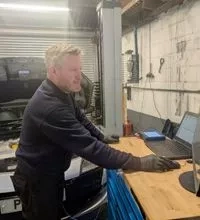Driving diagnostic intelligence with AI

Artificial intelligence is impacting every part of automotive, from the vehicles themselves to how they’re sold, but it’s also coming into the workshop. Companies hope that the technology will help streamline maintenance, work boosting productivity.
Diagnostics is the next big step for AI and firms are integrating the technology into tools to hopefully help technicians save time and improve accuracy.
For Delphi, a huge name in automotive, AI is at the heart of its mission to enhance user experiences and drive industry innovation. “By embedding AI into our diagnostic solutions, we’re addressing complex challenges and paving the way for a smarter, more efficient automotive aftermarket,’ it says.
The firm wants to create diagnostic systems that are both intelligent and intuitive, giving technicians step-by-step guidance and actionable insights in order to simplify processes, whether dealing with complex faults or routine issues.
“By refining our algorithms with real-world feedback, we ensure our tools deliver reliable, precise results every time. This helps technicians save time, reduce stress, and improve accuracy,” it says.
Delphi hopes that AI in its diagnostic services can help workshops and technicians in multiple ways.
It says that by analysing inputs and suggesting data-driven solutions, diagnostics can become faster and more accurate. But it isn’t only about finding faults, Delphi thinks AI will be able to deliver data-backed lead time estimates, helping garages forecast needs, enhance efficiency, and build customer trust.
Keeping pace with change
Sibros may not be a name everyone is familiar with, but the US firm is working to accelerate the transition to software-defined mobility. It’s keen to see AI powered diagnostics as it suggests that traditional approaches aren’t equipped to handle the complexity of modern software-defined vehicles.
The company says: “AI-driven diagnostics are the future of vehicle maintenance, providing the tools to transition from reactive to proactive service models. With continuous data monitoring, predictive analytics, and remote capabilities, AI diagnostics minimise downtime, reduce costs, and enable new business models.”
Importantly Sibros doesn’t see AI diagnostics as a replacement for technician skill and knowledge, but a supplementary tool to help them.
“One of the most compelling features of AI-driven diagnostics is the AI Diagnostic Assistant, which bridges the gap between vehicle data and technician expertise. This assistant, powered by natural language processing and deep learning, interacts directly with technicians, providing real-time troubleshooting guidance. By analysing a combination of historical repair data, technical manuals, and telemetry, it can offer actionable steps to resolve even complex issues,” says Sibros.
In practice that could mean if a technician receives an alert that a vehicle’s ADAS isn’t calibrating correctly, the AI assistant could analyse diagnostic logs and identify the issue stems from a sensor misalignment. From here it could walk the technician through the recalibration process according to Sibros.
Out with the old
Using AI to help build better processes is something that companies including Laser Tools can see happening in the future, injecting itself in the day-to-day running of workshops.
Mark Softley, Technical Director at Laser Tools says: “I can see AI being very useful for guided diagnostics of all sorts, [both] electronic and non-electronic. I can definitely see guided diagnostics using AI more and more.”
Softly thinks that AI could easily be used as part of a support package for electronic OBD type diagnostic routines as well non-electronic diagnostics, replacing older style flow diagrams for example to help simplify processes.
Automotive is embracing AI, and no matter what part of the sector you work in it’s likely it’ll have an impact on the way you work. Diagnostics is a logical move, but rather than do away with technicians’ knowledge, it’ll supplement it, helping improve areas such as problem solving for complex issues. In turn that could streamline the workshop, making them more productive.




